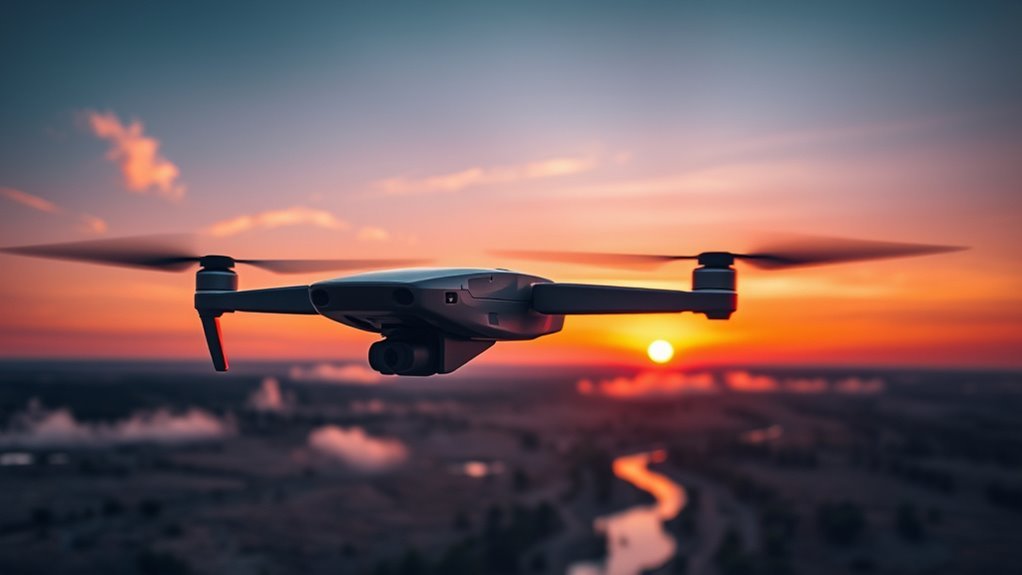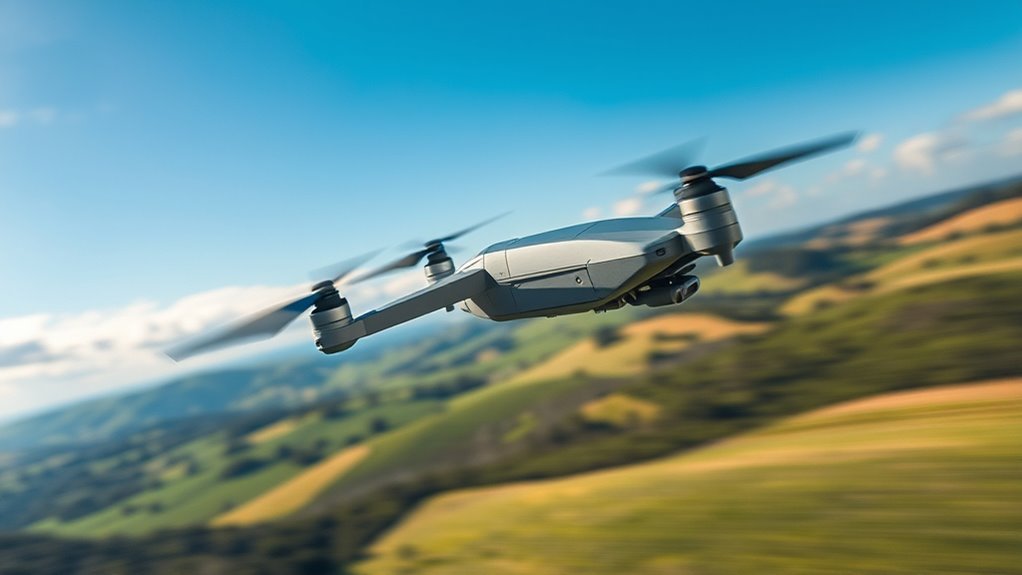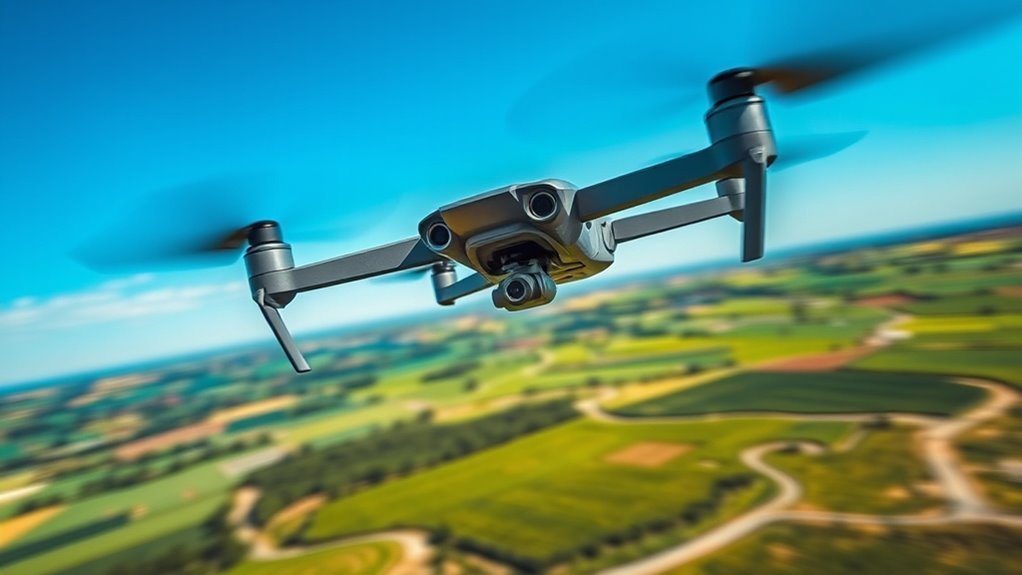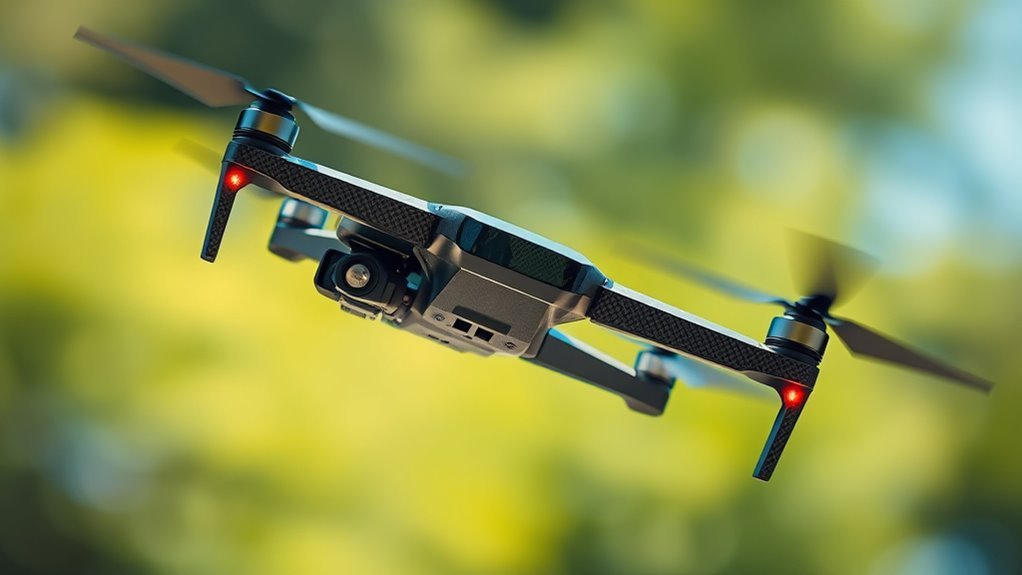You’ll find fast drones reaching speeds over 150 mph, with record holders nearing 179 mph thanks to advances in lightweight materials, brushless motors, and aerodynamic designs. Racing drones typically hit 60-120 mph using high KV motors and carbon fiber frames, while military models can exceed 300 mph for rapid reconnaissance. Battery efficiency and propulsion systems critically affect sustained velocity. Understanding this complex interplay of technology and design will reveal how drones achieve such remarkable speeds and what’s driving future improvements.
Factors Influencing Drone Speed

Although drone speed depends on multiple variables, understanding the primary factors influencing it can help you optimize performance or select the right model. Speed measurement involves analyzing thrust-to-weight ratio, motor power, and propeller efficiency, which directly dictate acceleration and top velocity. Aerodynamics also play an essential role; a streamlined frame reduces drag, enabling higher speeds. Environmental factors greatly impact actual speed—wind resistance, air density, and temperature can alter performance from theoretical maximums. You need to take into account battery capacity and weight distribution too, as they affect endurance and maneuverability. By carefully evaluating these elements, you gain the freedom to push your drone’s limits or choose one that matches your speed requirements while maintaining control and stability in varied conditions.
Record-Holding Fastest Drones

You’ll find that record-holding drones achieve top speeds through advanced aerodynamics and optimized propulsion systems. These world speed records showcase the integration of lightweight materials and high-efficiency motors. Understanding the technology behind these speeds is key to grasping how drones push performance boundaries.
World Speed Records
Several drones have set remarkable world speed records, pushing the boundaries of aerial velocity through advanced engineering and aerodynamic design. You’ll find that these record-holding drones achieve speeds exceeding 150 mph, a demonstration of innovations in lightweight materials and powerful propulsion systems. In drone racing and speed competitions, pilots exploit this performance to navigate courses with precision and agility. The current fastest drone, verified under strict conditions, reached speeds close to 179 mph, highlighting how technical refinement directly influences maximum velocity. For you, understanding these records means appreciating the interplay of mechanics, control algorithms, and pilot skill that enable these machines to dominate the skies. These benchmarks not only inspire freedom in flight but also set new standards for what’s possible in high-speed drone technology.
Technology Behind Speed
When you examine the technology behind the fastest drones, you’ll find a combination of cutting-edge materials, high-efficiency brushless motors, and enhanced aerodynamic frames. The propulsion systems are meticulously engineered to maximize thrust-to-weight ratios, enabling rapid acceleration and sustained top speeds. Speed measurement is critical, relying on GPS telemetry and optical sensors to validate performance with precision. Lightweight carbon fiber composites reduce drag and structural mass, allowing the drone to maneuver with minimal resistance. Advanced electronic speed controllers finely regulate motor output, ensuring ideal power delivery while maintaining thermal stability. By integrating these elements, designers grant you the freedom to push speed boundaries without compromising control or safety. Understanding this technology lets you appreciate how record-holding drones achieve their remarkable velocities through engineering excellence.
Racing Drones and Their Speed Capabilities

Although racing drones vary widely in design, their speed capabilities are primarily influenced by motor power, frame weight, and aerodynamic efficiency. When you engage in drone racing or speed competitions, these factors define how fast your drone can accelerate and maintain velocity through complex courses. Balancing power and weight guarantees ideal control and freedom, while aerodynamics reduce drag to maximize speed.
| Component | Influence on Speed | Typical Range |
|---|---|---|
| Motor Power | Directly increases thrust | 2300-2700 KV |
| Frame Weight | Inversely affects agility | 250-350 grams |
| Aerodynamics | Minimizes air resistance | Streamlined carbon fiber |
| Battery Capacity | Sustains peak performance | 4S-6S LiPo, 1300-1800mAh |
Mastering these elements lets you push limits in drone racing.
Commercial Drones With Impressive Speeds
If you’re looking for commercial drones that combine speed with reliability, you’ll find models engineered to deliver impressive velocities without sacrificing stability or control. These drones excel in commercial drone applications such as surveying, inspection, and delivery, where rapid transit enhances operational efficiency. Advanced aerodynamics, lightweight materials, and powerful propulsion systems enable speeds often exceeding 70 mph, balancing velocity with precise maneuverability. However, your choice must account for drone speed regulations, which vary by region and restrict maximum allowable speeds to guarantee safety and compliance. Understanding these constraints helps you select drones that optimize performance while adhering to legal frameworks. Ultimately, high-speed commercial drones grant you the freedom to complete tasks swiftly and effectively, pushing the boundaries of what’s achievable in professional aerial operations.
Military Drones and Speed Performance
How fast can military drones really go, and what does that mean for their operational effectiveness? Speed is a critical factor in military applications, impacting response time and mission success. High velocity enhances a drone’s ability to perform rapid surveillance, evade threats, and deploy countermeasures efficiently. When considering speed, you must also weigh how it complements surveillance capabilities and overall mission parameters.
Speed is crucial for military drones, boosting rapid surveillance, threat evasion, and mission success.
- Speeds often exceed 300 mph in advanced models, enabling swift area coverage.
- Rapid acceleration improves tactical flexibility during reconnaissance.
- High speed reduces exposure time to enemy defenses, increasing survivability.
- Ideal speed balances endurance with swift data collection and transmission.
Understanding these dynamics helps you appreciate how speed elevates military drones beyond basic surveillance, empowering freedom through enhanced operational reach.
Design Elements That Boost Drone Speed
You’ll find that lightweight frame materials substantially reduce drag and improve acceleration. Coupled with aerodynamic body shapes, these design choices minimize air resistance to enhance top speed. High-power motor systems then convert electrical energy into thrust efficiently, pushing drones to their velocity limits.
Lightweight Frame Materials
Although the motor and propeller configuration greatly influence a drone’s speed, the choice of frame material plays a critical role in maximizing performance by minimizing weight without sacrificing structural integrity. When selecting drone materials, you must focus on reducing frame weight to enhance acceleration and maneuverability. Lightweight frames enable you to push your drone faster while maintaining control and durability. Consider these materials:
- Carbon fiber: Offers exceptional strength-to-weight ratio and rigidity.
- Aluminum alloys: Lightweight, cost-effective, and moderately stiff.
- Magnesium alloys: Even lighter than aluminum with good mechanical properties.
- High-strength plastics: Ultra-light but may compromise durability under stress.
Choosing the right material balances weight and strength, freeing you to achieve higher speeds without structural failure.
Aerodynamic Body Shapes
Reducing frame weight with advanced materials sets the stage, but shaping the drone’s body to cut through air with minimal drag is equally important for achieving top speeds. You need to apply aerodynamic principles rigorously, focusing on body shape optimization that minimizes turbulence and drag coefficients. Streamlined contours reduce air resistance, allowing your drone to slice through airflow efficiently, which directly enhances velocity and stability. Consider tapered noses, smooth surfaces, and enclosed components to prevent airflow separation. Even subtle shape adjustments can lead to measurable speed gains. By prioritizing aerodynamic efficiency, you guarantee your drone not only accelerates faster but maintains top speed with less energy loss. This design approach grants you the freedom to push performance limits without compromising control or endurance.
High-Power Motor Systems
Three core factors define the effectiveness of high-power motor systems in boosting drone speed: thrust output, power-to-weight ratio, and thermal management. When you optimize these, your drone achieves maximum acceleration and sustained high velocity. Integrating high efficiency propellers minimizes energy loss, enhancing thrust without extra weight. Optimized flight controllers precisely manage motor response, ensuring power delivery aligns with aerodynamic demands. Key design elements include:
- High torque brushless motors for sustained thrust
- Lightweight materials reducing overall mass
- Advanced cooling solutions to prevent thermal throttling
- Intelligent ESCs (Electronic Speed Controllers) for real-time power modulation
The Role of Battery and Motor Technology
When you consider the top speeds of fast drones, the advancements in battery and motor technology play a crucial role in pushing performance boundaries. Battery efficiency directly affects flight duration and power output, enabling drones to sustain higher speeds without sacrificing operational time. Improvements in energy density and discharge rates allow you to harness more power from lighter, compact cells. Simultaneously, motor advancements—such as higher torque-to-weight ratios and optimized electromagnetic designs—translate electrical energy into mechanical thrust more effectively. These innovations reduce energy loss and increase responsiveness, granting you greater control at extreme velocities. Together, enhanced battery efficiency and cutting-edge motor technology empower you to experience unprecedented speed and agility, expanding the freedom to explore and maneuver with precision in dynamic environments.
Comparing Drone Speeds to Fastest Animals
Advancements in battery and motor technology have enabled drones to reach speeds that rival those of some of the fastest animals on Earth. When comparing drone speeds to animal adaptations, you’ll notice drones now mimic nature’s efficiency, especially in drone migration patterns designed for endurance and velocity. Consider these comparisons:
Drones now match the speed and efficiency of Earth’s fastest animals through cutting-edge technology advancements.
- Peregrine falcon: dives up to 240 mph; drones can replicate rapid vertical descents.
- Cheetah: sprints at 60-70 mph; high-speed drones match horizontal bursts.
- Sailfish: swims near 68 mph; underwater drones approach similar velocities.
- Dragonflies: agile flyers with speeds around 35 mph; quadcopters excel in maneuverability.
Safety Considerations When Flying High-Speed Drones
When operating high-speed drones, you need to implement strict risk assessment protocols to identify potential hazards before flight. Wearing appropriate protective gear is essential to minimize injury from unexpected collisions or malfunctions. Prioritizing these safety measures helps maintain control and reduces the likelihood of accidents.
Risk Assessment Protocols
Although high-speed drones offer remarkable performance capabilities, you must rigorously evaluate potential risks before operating them. Effective risk assessment protocols are essential to balance your desire for freedom with necessary safety regulations. You need a structured approach to risk management that anticipates hazards and mitigates impact. Key steps include:
- Analyzing environmental factors such as wind, obstacles, and population density
- Verifying compliance with local and federal safety regulations
- Conducting pre-flight inspections and system diagnostics
- Establishing emergency response procedures for loss of control or technical failure
Protective Gear Usage
Beyond evaluating risks, wearing proper protective gear plays a significant role in safeguarding you while operating high-speed drones. When drones reach high velocities, the potential for physical injury escalates, making safety measures non-negotiable. You should prioritize helmets with impact resistance and eye protection designed to shield against debris or sudden drone malfunctions. Additionally, gloves that enhance grip and protect from sharp edges contribute to operational control and injury prevention. Integrating protective gear into your routine complements risk assessments by mitigating hazards that aren’t always predictable. This approach enables you to maintain your freedom to fly aggressively while adhering to essential safety measures that reduce the likelihood and severity of accidents. Ultimately, consistent use of protective gear is a technical necessity for responsible high-speed drone piloting.
Future Trends in Drone Speed Advancements
As drone technology evolves, you’ll notice significant breakthroughs in propulsion systems and materials science that directly impact speed capabilities. Future technologies are pushing the envelope, enabling drones to achieve unprecedented velocities while balancing aerodynamic efficiency and energy consumption. However, speed regulations will shape how these advancements translate into real-world applications, ensuring safe integration with manned aircraft and populated areas. Key trends you should watch include:
- Development of lightweight composite materials enhancing structural integrity without added weight
- Adoption of hybrid propulsion systems combining electric and combustion power for extended speed bursts
- Integration of AI-driven flight controllers optimizing speed and stability in real time
- Regulatory frameworks evolving to accommodate higher-speed operations while maintaining safety
These innovations will empower you to push drone performance boundaries responsibly and freely.

